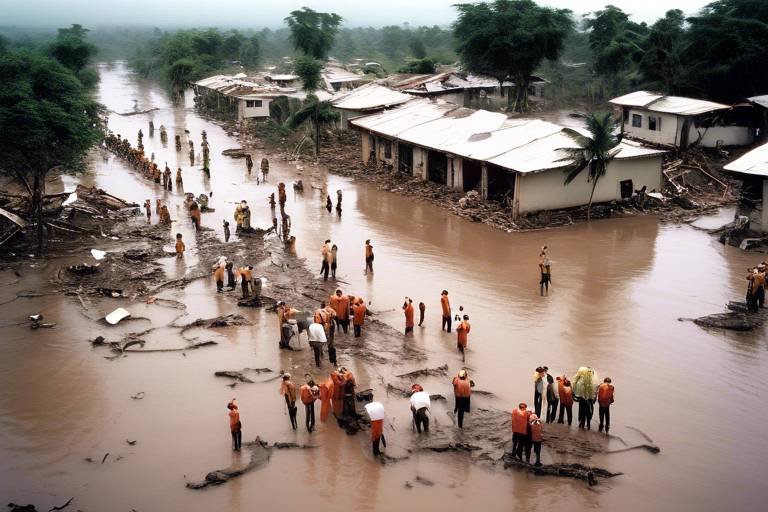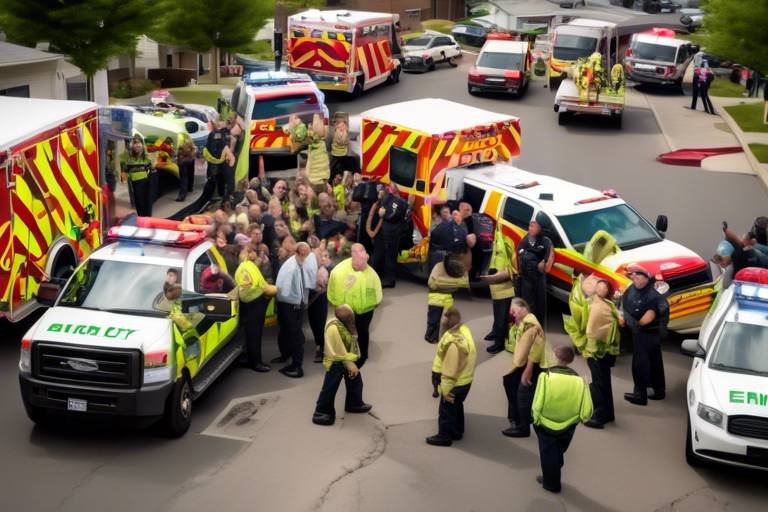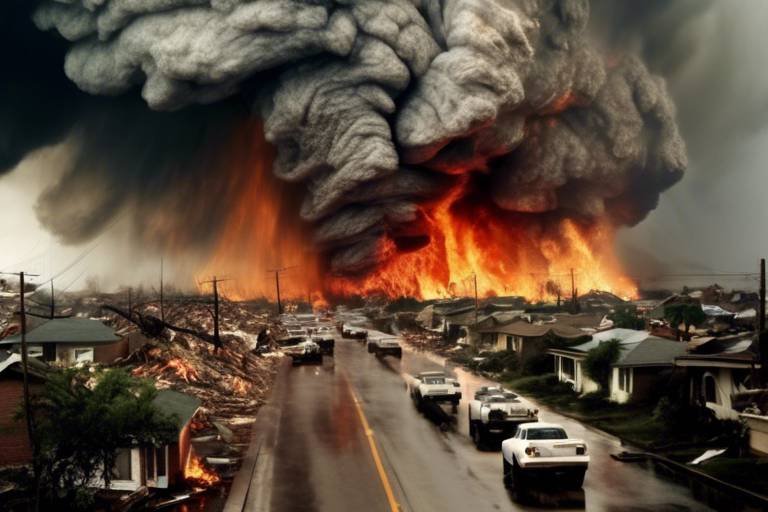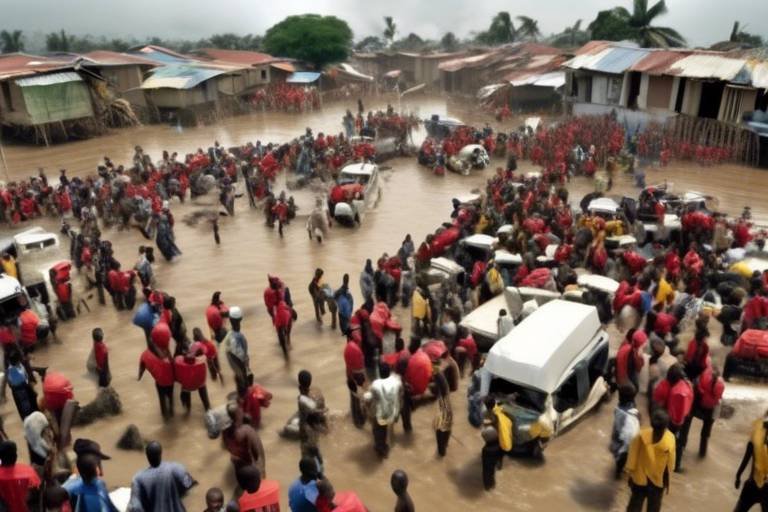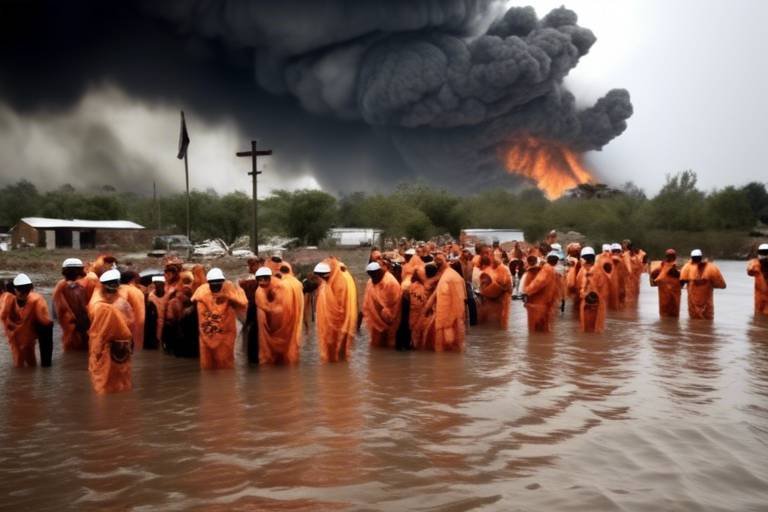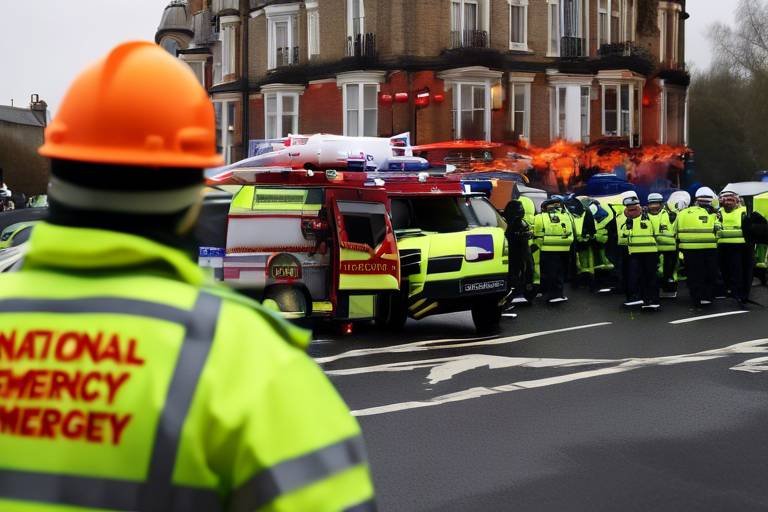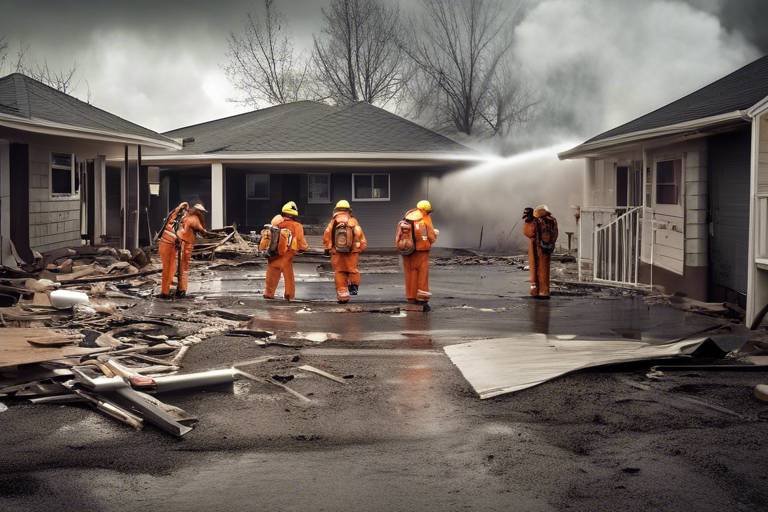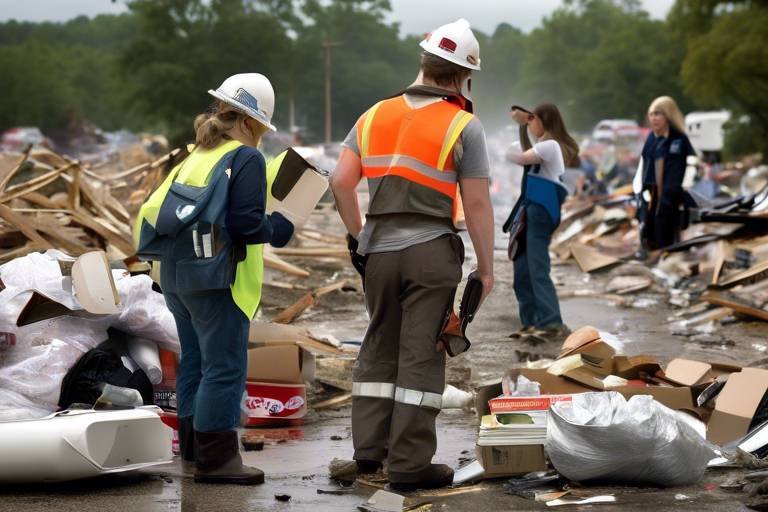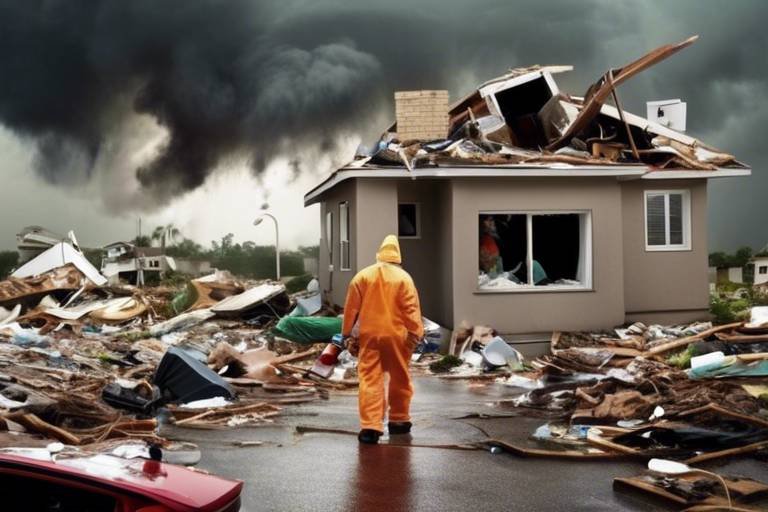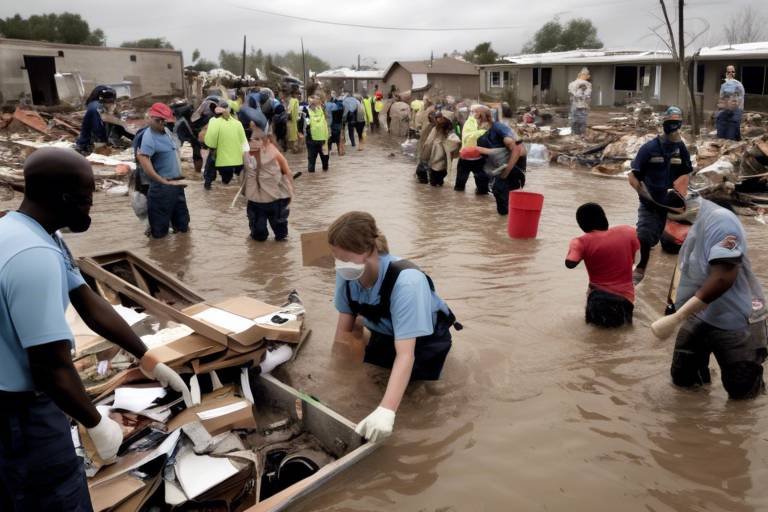Disaster Management Policies – A Global Review
Disaster management policies are essential frameworks that guide nations and communities in preparing for, responding to, and recovering from various disasters, whether they are natural or man-made. In a world where the frequency and intensity of such events are on the rise, understanding these policies is more crucial than ever. They not only help mitigate risks but also enhance resilience among populations. This article delves into the myriad of disaster management policies implemented globally, analyzing their effectiveness, the challenges they face, and the collaborative efforts that are necessary to improve preparedness and response strategies.
The landscape of disaster management is diverse and complex, shaped by cultural, geographical, and political factors unique to each region. For instance, countries prone to earthquakes, like Japan, have developed stringent building codes and early warning systems, while island nations may focus more on hurricane preparedness and evacuation plans. These tailored approaches highlight the importance of context in developing effective disaster management strategies.
Moreover, the effectiveness of these policies can often be measured by how well they integrate community involvement and technological advancements. Communities that are actively engaged in disaster preparedness not only enhance their own resilience but also contribute to a collective response effort that can save lives. Similarly, technology plays a pivotal role in modern disaster management, enabling quicker response times and more efficient resource allocation. From mobile applications that alert citizens to impending threats to drones that assess damage in real-time, the intersection of technology and disaster management is a promising frontier.
However, despite these advancements and frameworks, challenges persist. Funding limitations, lack of political will, and coordination issues between agencies can severely hinder effective disaster management. Understanding these obstacles is crucial for developing solutions that enhance the overall efficacy of disaster management policies worldwide.
As we explore the various dimensions of disaster management policies, it becomes evident that a collaborative approach, combining local knowledge with international best practices, is essential for building a resilient future. The lessons learned from past disasters can guide us in shaping policies that not only respond to immediate threats but also foster long-term resilience in communities worldwide.
- What are disaster management policies?
Disaster management policies are strategic frameworks that guide how governments and organizations prepare for, respond to, and recover from disasters.
- Why is community involvement important in disaster management?
Community involvement ensures that local knowledge is utilized, which can lead to more effective and tailored disaster response strategies.
- How does technology enhance disaster management?
Technology improves disaster management through early warning systems, data analytics, and communication tools that facilitate quick and coordinated responses.
- What are some common challenges in implementing disaster management policies?
Challenges include funding limitations, lack of political will, and coordination issues among different agencies and organizations.

Historical Context of Disaster Management
Understanding the evolution of disaster management policies is crucial for grasping the complexities of modern practices. Historically, societies have faced various challenges posed by natural and man-made disasters. From ancient civilizations that relied on local knowledge to navigate floods and earthquakes, to the establishment of formalized responses in the 20th century, the journey has been transformative. For instance, the catastrophic events of the early 1900s, such as the 1906 San Francisco earthquake, highlighted the need for systematic approaches to disaster response, leading to the development of policies that prioritize preparedness and recovery.
In the mid-20th century, the world saw a significant shift in disaster management approaches, largely influenced by the increasing frequency of disasters and the growing recognition of their socio-economic impacts. The aftermath of World War II, for example, prompted nations to rethink their strategies for disaster preparedness. This era marked the beginning of international collaboration, as countries began to understand that disasters do not respect borders. The establishment of the United Nations in 1945 played a pivotal role in fostering global cooperation in disaster management.
As we moved into the late 20th century, the focus shifted towards more comprehensive frameworks. The International Decade for Natural Disaster Reduction (IDNDR) from 1990 to 2000 was a landmark initiative that aimed to reduce the impact of natural disasters through improved preparedness and response strategies. This period laid the groundwork for more structured policies and the integration of scientific research into disaster management practices.
Today, disaster management policies are influenced by a myriad of factors, including technological advancements, environmental changes, and socio-political dynamics. The rise of climate change as a pressing global issue has further complicated the landscape, necessitating a reevaluation of existing policies. Countries are now more inclined to adopt a multi-hazard approach that encompasses various risks, from earthquakes to pandemics, recognizing that the interconnectedness of these threats requires a cohesive response.
To illustrate this evolution, let’s take a look at a brief timeline of significant milestones in disaster management history:
| Year | Event | Impact |
|---|---|---|
| 1906 | San Francisco Earthquake | Highlighting the need for organized disaster response. |
| 1945 | Formation of the United Nations | Encouraging international cooperation in disaster management. |
| 1990-2000 | International Decade for Natural Disaster Reduction | Promoting disaster preparedness globally. |
| 2015 | Sendai Framework for Disaster Risk Reduction | Establishing a global blueprint for disaster risk management. |
This historical context not only sheds light on the progress made in disaster management but also emphasizes the challenges that lie ahead. As we continue to face an ever-evolving landscape of risks, understanding our past is essential in shaping effective, resilient policies for the future.

International Frameworks and Agreements
When it comes to disaster management, the importance of international cooperation cannot be overstated. Countries across the globe face the daunting challenge of natural and man-made disasters, and no single nation can tackle these issues alone. This is where come into play. They provide a structured approach to disaster preparedness, response, and recovery, ensuring that nations can work together effectively.
One of the most significant agreements in recent history is the Sendai Framework for Disaster Risk Reduction 2015-2030. Adopted at the Third UN World Conference on Disaster Risk Reduction in Sendai, Japan, this framework aims to significantly reduce disaster risk and losses in lives, livelihoods, and health. The Sendai Framework emphasizes a shift from crisis management to risk management, focusing on enhancing resilience and preparedness. This transition is crucial as it encourages nations to invest in preventive measures rather than merely responding to disasters after they occur.
The Sendai Framework outlines four priorities for action:
- Understanding disaster risk: This involves improving data collection and analysis to better anticipate and mitigate risks.
- Strengthening disaster risk governance: Effective governance structures ensure that disaster management policies are implemented efficiently.
- Investing in disaster risk reduction: Allocating resources towards risk reduction initiatives can save lives and reduce economic impacts.
- Enhancing disaster preparedness for effective response: Preparedness programs are essential for ensuring that communities can respond swiftly and effectively when disasters strike.
In addition to the Sendai Framework, other international agreements also play a pivotal role in shaping disaster management policies. For instance, the Paris Agreement addresses climate change, which is increasingly linked to the frequency and severity of natural disasters. By committing to reducing greenhouse gas emissions, countries are not only working towards a sustainable future but also enhancing their resilience to climate-related disasters.
Moreover, the Hyogo Framework for Action, which preceded the Sendai Framework, laid the groundwork for many of the principles currently in use. It was a comprehensive blueprint that emphasized the importance of local knowledge and community involvement in disaster risk reduction.
These international frameworks foster collaboration and knowledge sharing among nations, enabling them to learn from each other's successes and failures. They create a platform for countries to engage in dialogues, share resources, and develop joint strategies. This collaborative spirit is essential, especially in times of crisis when swift action is required.
However, while these frameworks provide a solid foundation, the real challenge lies in their implementation. Many countries struggle with translating these agreements into actionable policies due to various factors, including political instability, limited funding, and insufficient local capacity. Therefore, it is crucial for nations to not only adopt these frameworks but also to commit to the necessary investments and training required to make them effective.
In summary, international frameworks and agreements are vital for effective disaster management. They guide nations in their preparedness and response strategies, fostering collaboration and enhancing resilience. As the world continues to face increasing threats from disasters, the role of these agreements will only grow, making it essential for countries to engage actively and invest in their implementation.
- What is the Sendai Framework? The Sendai Framework is a global agreement aimed at reducing disaster risk and losses, focusing on resilience and preparedness.
- How do international agreements help in disaster management? They provide guidelines, promote collaboration, and facilitate resource sharing among nations to enhance disaster response and recovery.
- What challenges do countries face in implementing these frameworks? Common challenges include political instability, funding limitations, and lack of local capacity.

National Disaster Management Policies
When we talk about , we're diving into a complex yet fascinating web of strategies and frameworks that countries adopt to tackle the unpredictable nature of disasters. Each nation has its own unique set of policies tailored to address specific risks, shaped by geographical, social, and economic factors. For instance, countries prone to earthquakes, like Japan, have developed rigorous building codes and early warning systems that reflect their need to protect lives and infrastructure. On the other hand, nations facing frequent floods, such as Bangladesh, focus on extensive flood management systems, including riverbank reinforcement and community awareness programs.
Moreover, these policies are not just about immediate response; they encompass a holistic approach that includes prevention, preparedness, response, and recovery. The effectiveness of these policies often hinges on how well they are integrated into the broader governance framework. In many cases, national policies are influenced by international frameworks, such as the Sendai Framework for Disaster Risk Reduction, which emphasizes a proactive approach to disaster management.
One key aspect of national policies is the collaboration between various government agencies and stakeholders. For example, in the United States, the Federal Emergency Management Agency (FEMA) works alongside local and state governments to create comprehensive emergency plans. This collaboration is crucial because, during a disaster, the coordination of efforts can mean the difference between chaos and an organized response. The table below illustrates how different countries structure their disaster management policies:
| Country | Key Features of Disaster Management Policy | Focus Areas |
|---|---|---|
| Japan | Strict building codes, early warning systems, community drills | Earthquake preparedness, public education |
| Bangladesh | Flood management systems, community awareness programs | Flood risk reduction, community resilience |
| United States | FEMA coordination, state and local emergency management | Preparedness, response, recovery |
| Germany | Integrated risk management, public-private partnerships | Flood and storm response, infrastructure resilience |
However, despite the existence of these well-structured policies, challenges often arise in their implementation. For instance, funding limitations can significantly hinder the execution of disaster preparedness programs. Additionally, the political landscape can affect the prioritization of disaster management initiatives, leading to inconsistent application of policies across different regions. In some cases, local governments may lack the necessary training or resources to effectively implement national guidelines, which can create gaps in response capability.
It's also important to note that the effectiveness of these policies is often evaluated through real-life scenarios. After a disaster strikes, governments analyze their response to identify strengths and weaknesses. This feedback loop is essential for continuous improvement and adaptation of policies. Countries that have experienced significant disasters often emerge with revised policies that better reflect the lessons learned, thereby enhancing their resilience for future events.
In conclusion, the landscape of national disaster management policies is as diverse as the challenges they aim to address. By examining the unique approaches of different countries, we can gain valuable insights into best practices and potential areas for improvement. As we move forward, the integration of community involvement, technological advancements, and international collaboration will be key to developing more robust disaster management strategies that can withstand the test of time.
- What are the primary goals of national disaster management policies? The primary goals are to reduce disaster risks, enhance preparedness, ensure effective response, and facilitate recovery.
- How do international frameworks influence national policies? International frameworks provide guidelines and best practices that countries can adopt to improve their disaster management strategies.
- What role does community involvement play in disaster management? Community involvement is crucial as it fosters local resilience and empowers individuals to take action before, during, and after a disaster.
- What challenges do countries face in implementing disaster management policies? Common challenges include funding limitations, lack of political will, and coordination issues among various agencies.

Community-Based Approaches
When it comes to disaster management, the saying "it takes a village" couldn't be more accurate. Community-based approaches are essential for building resilience and ensuring effective responses to disasters. These approaches empower local populations to take charge of their safety and preparedness, fostering a sense of ownership and responsibility. Imagine a neighborhood coming together to create an emergency plan—this not only strengthens community bonds but also enhances overall readiness.
One of the most significant benefits of community-based disaster management is the ability to tailor strategies to meet local needs. Each community has its unique characteristics, vulnerabilities, and resources. By involving residents in the planning process, disaster management policies can be more effective and relevant. For instance, a coastal town may prioritize flood preparedness, while a mountainous area may focus on wildfire prevention. This localized understanding is crucial for developing actionable plans that resonate with the community.
Moreover, community involvement fosters a culture of preparedness. When individuals are educated about potential risks and equipped with the necessary tools and knowledge, they are more likely to respond effectively during a crisis. Educational programs, workshops, and simulation exercises can play a pivotal role in this regard. For example, communities can organize drills that simulate disaster scenarios, allowing residents to practice their response in a safe environment. Such initiatives not only build confidence but also create a network of individuals ready to assist one another during an actual emergency.
In addition to education, community-based approaches often emphasize the importance of volunteer initiatives. Volunteers can significantly enhance a community's capacity to respond to disasters. They can act as first responders, assist in evacuation efforts, and provide support to affected individuals. The spirit of volunteerism not only strengthens community ties but also creates a safety net during challenging times. Local organizations can facilitate this by establishing volunteer programs that train and mobilize residents when disaster strikes.
It's also critical to recognize the role of technology in community-based disaster management. Social media platforms, mobile applications, and community alert systems can enhance communication and coordination efforts. For instance, a community might use a dedicated app to share real-time updates during a disaster or to organize resources and volunteers effectively. This technology-driven approach ensures that everyone is informed and can act swiftly, reducing panic and confusion during emergencies.
However, it's essential to acknowledge that implementing community-based approaches is not without challenges. Some communities may face barriers such as lack of funding, limited access to resources, or even skepticism among residents. To overcome these obstacles, it is crucial to foster partnerships between local governments, non-profits, and community organizations. By pooling resources and expertise, these entities can create a robust framework for disaster management that is both sustainable and effective.
In summary, community-based approaches to disaster management are not just beneficial; they are essential for building resilient societies. By empowering local populations, fostering education and volunteerism, and leveraging technology, communities can significantly enhance their preparedness and response capabilities. As we face an increasingly unpredictable world, investing in these grassroots initiatives will be key to safeguarding lives and property.
- What are community-based disaster management approaches?
These are strategies that involve local populations in the planning and execution of disaster preparedness and response efforts, ensuring that the unique needs and resources of the community are taken into account.
- How can communities prepare for disasters?
Communities can prepare by creating emergency plans, conducting drills, educating residents about risks, and establishing volunteer networks to assist during emergencies.
- What role does technology play in community disaster management?
Technology enhances communication and coordination during disasters through tools like social media, mobile apps, and community alert systems, ensuring timely information dissemination.
- What challenges do communities face in implementing these approaches?
Challenges can include funding limitations, lack of resources, and community skepticism, which can be addressed through partnerships and collaborative efforts.

Technology in Disaster Management
In today's fast-paced world, technology has become an indispensable ally in the realm of disaster management. Imagine a scenario where a hurricane is about to hit land, and the local authorities are able to predict its path with remarkable accuracy. This is not just a fantasy; it's a reality made possible by advancements in technology. From early warning systems to data analytics, the tools available today empower communities and governments to respond more effectively than ever before.
One of the most significant innovations in disaster management is the development of early warning systems. These systems utilize various technologies, including satellite imagery and meteorological data, to provide timely alerts about impending disasters. For instance, countries prone to earthquakes are now using seismic sensors that can detect tremors and send alerts seconds before the shaking begins. This precious time can be the difference between life and death, allowing people to take cover or evacuate.
Moreover, the rise of data analytics has transformed how we understand and predict disasters. By analyzing vast amounts of data from previous incidents, researchers can identify patterns and trends that help forecast future events. For example, machine learning algorithms can process historical weather data to predict flooding in specific areas with greater accuracy. This predictive capability not only saves lives but also aids in efficient resource allocation during emergencies.
Social media has also emerged as a powerful tool in disaster management. During crises, platforms like Twitter and Facebook become vital channels for disseminating information quickly. Authorities can communicate real-time updates, while citizens can share their experiences and needs, creating a dynamic flow of information. This two-way communication fosters a sense of community and enables quicker response times. However, it's essential to manage misinformation, which can spread just as rapidly and create panic.
The integration of technology in disaster management is not without its challenges. For one, there is the issue of accessibility. Not all communities have the same level of access to technology, which can create disparities in preparedness and response. Additionally, the reliance on technology raises concerns about cybersecurity. As we increasingly depend on digital systems, ensuring their security against potential threats becomes paramount.
To illustrate the impact of technology in disaster management, consider the following table that highlights some of the key technologies and their applications:
| Technology | Application |
|---|---|
| Early Warning Systems | Alerting communities about impending disasters like hurricanes and tsunamis. |
| Data Analytics | Predicting disaster patterns and resource allocation. |
| Social Media | Real-time communication and information sharing during crises. |
| Drones | Assessing damage and delivering supplies in hard-to-reach areas. |
In summary, technology in disaster management is not just about tools and software; it's about enhancing our ability to save lives and minimize loss. As we continue to innovate and integrate new technologies, the potential for improved disaster preparedness and response becomes limitless. The question we must ask ourselves is: how can we ensure that these technologies are accessible and effective for everyone, especially the most vulnerable communities? The answer lies in collaboration, education, and a commitment to leveraging technology for the greater good.
- What role does technology play in disaster management? Technology enhances preparedness, response, and recovery efforts by providing timely information, improving communication, and enabling data analysis.
- How do early warning systems work? Early warning systems use data from various sources, such as satellites and sensors, to predict disasters and alert communities in advance.
- Can social media be trusted during disasters? While social media is a valuable tool for real-time updates, it's crucial to verify information to avoid spreading misinformation.
- What are some challenges of using technology in disaster management? Challenges include accessibility, cybersecurity threats, and the need for training to effectively use technological tools.

Challenges in Implementation
Despite the existence of robust disaster management policies, the journey from theory to practice is often fraught with challenges. One of the most significant hurdles is funding limitations. Many countries allocate insufficient resources to disaster preparedness and response initiatives, which can lead to inadequate infrastructure and lack of necessary training for personnel. Imagine trying to build a sturdy house with only a handful of bricks; without proper funding, the foundation of disaster management remains shaky.
Another challenge is the political will behind disaster management policies. In many cases, political agendas can overshadow the urgent need for effective disaster response. When leaders prioritize short-term gains over long-term resilience, it becomes difficult to implement comprehensive strategies that address both current and future risks. This lack of commitment can lead to fragmented efforts, where initiatives are launched but not sustained, much like a half-finished puzzle that never reveals the complete picture.
Moreover, coordination issues between various stakeholders often complicate disaster management efforts. Different agencies, organizations, and levels of government may have overlapping responsibilities, which can result in confusion and inefficiency. For instance, if one group is focused on evacuation protocols while another is managing resource distribution, the lack of clear communication can lead to a chaotic response during a crisis. A well-coordinated approach is essential for effective disaster management, akin to a symphony where every instrument must harmonize to create a beautiful melody.
Additionally, the diverse nature of disasters presents a unique challenge. Natural disasters, such as earthquakes and floods, require different responses compared to man-made disasters, like industrial accidents or terrorist attacks. This diversity necessitates tailored strategies, which can be resource-intensive and complex to develop. Countries must continuously adapt their policies to reflect the changing landscape of risks, much like a chameleon adjusting its colors to blend into its environment.
Furthermore, the lack of public awareness and community engagement remains a significant barrier. Many individuals are unaware of the risks they face or the steps they can take to prepare for a disaster. This gap in knowledge can lead to panic and disorder during emergencies. To combat this, communities must be educated and involved in disaster preparedness initiatives. Programs that promote awareness and training can empower citizens to take proactive measures, transforming them from passive observers into active participants in their safety.
Finally, the impact of climate change cannot be overstated. As weather patterns become more unpredictable, the frequency and intensity of disasters are increasing. This changing climate presents a moving target for disaster management policies, requiring constant reassessment and adaptation. Countries must invest in research and innovation to develop strategies that can withstand the evolving threats posed by climate change, ensuring that disaster management remains relevant and effective.
In conclusion, while the challenges in implementing disaster management policies are significant, they are not insurmountable. By addressing funding issues, fostering political commitment, enhancing coordination, promoting public awareness, and adapting to climate change, nations can strengthen their disaster management frameworks. The road may be rocky, but with resilience and determination, we can pave the way for a safer future.
- What are the main challenges in disaster management implementation? The main challenges include funding limitations, lack of political will, coordination issues, diverse disaster types, lack of public awareness, and impacts of climate change.
- How can communities improve disaster preparedness? Communities can improve preparedness through education programs, volunteer initiatives, and engaging local citizens in disaster response planning.
- Why is political will important in disaster management? Political will is crucial as it ensures that disaster management policies receive the necessary support, resources, and attention to be effectively implemented.

Case Studies of Successful Policies
When it comes to disaster management, learning from those who have navigated the storm can be incredibly enlightening. Around the globe, there are shining examples of policies that have not only worked effectively but have also set the stage for future improvements. Let's dive into some of these remarkable case studies that highlight innovative approaches to disaster response and recovery.
One of the most notable examples comes from Japan, a country that is no stranger to natural disasters, particularly earthquakes and tsunamis. Following the catastrophic events of March 2011, Japan implemented a comprehensive disaster management policy that emphasizes community preparedness and technological integration. The government established a robust early warning system that utilizes seismic sensors and predictive modeling to alert citizens minutes before an earthquake strikes. This system has been credited with saving countless lives, as it gives people the critical time needed to take cover and prepare for the impending disaster.
Moreover, Japan's local governments have actively engaged communities through regular disaster drills and educational programs. They have fostered a culture of preparedness, where citizens are encouraged to create personal emergency plans and stockpile essential supplies. The success of this policy can be seen in the high levels of public participation in disaster preparedness activities, which has significantly enhanced the overall resilience of communities.
Another compelling case study is found in the Philippines, a nation frequently affected by typhoons and flooding. In response to the increasing frequency of these disasters, the Philippine government adopted the National Disaster Risk Reduction and Management Act in 2010. This legislation established a framework for disaster risk reduction that involves various stakeholders, including local governments, NGOs, and community organizations. One of the standout features of this policy is its focus on community-based disaster risk management.
Through this approach, local communities are empowered to assess their own risks and develop tailored response strategies. For instance, in the municipality of San Francisco, local officials worked closely with residents to create a community disaster response plan that includes evacuation routes, emergency shelters, and communication strategies. This collaborative effort has led to a remarkable increase in community awareness and preparedness, which has proven invaluable during recent typhoons.
In addition to these examples, we can also look at the United States, where the Federal Emergency Management Agency (FEMA) has implemented the Community Rating System (CRS). This program incentivizes communities to adopt floodplain management practices that exceed the minimum requirements set by federal regulations. By doing so, communities can earn discounts on flood insurance premiums for their residents. The CRS not only encourages proactive measures to reduce flood risk but also fosters community engagement in disaster preparedness.
To illustrate the effectiveness of these policies, consider the following table that summarizes key outcomes from these case studies:
| Country | Policy/Program | Key Outcomes |
|---|---|---|
| Japan | Comprehensive Disaster Management Policy | Enhanced early warning systems, high public participation in drills |
| Philippines | National Disaster Risk Reduction and Management Act | Community empowerment, tailored disaster response strategies |
| USA | Community Rating System | Discounted flood insurance premiums, increased community engagement |
These case studies highlight that successful disaster management policies are not one-size-fits-all solutions. Instead, they are crafted through a combination of government initiatives, community involvement, and technological advancements. By studying these successes, other nations can glean valuable insights and adapt these strategies to their unique contexts. Ultimately, the goal is to enhance resilience and ensure that communities are better prepared for whatever challenges lie ahead.
Q: What is the most effective way to prepare for a disaster?
A: The most effective way to prepare for a disaster is to create a comprehensive emergency plan, which includes identifying escape routes, emergency contacts, and essential supplies. Regular drills and community engagement also play a significant role in enhancing preparedness.
Q: How can technology improve disaster management?
A: Technology can improve disaster management through early warning systems, real-time data analytics, and social media communication. These tools help coordinate responses and disseminate critical information quickly during emergencies.
Q: Why is community involvement important in disaster management?
A: Community involvement is crucial because local residents are often the first responders in a disaster. Empowering communities to take charge of their disaster preparedness ensures that response strategies are relevant, effective, and tailored to specific risks.

The Future of Disaster Management
As we step into an era marked by unprecedented climate change and increasing urbanization, the future of disaster management is more crucial than ever. The landscape of disaster response is evolving, and so must our strategies to effectively tackle these challenges. With the frequency and intensity of disasters on the rise, it is essential to adopt a forward-thinking approach that emphasizes innovation, collaboration, and adaptability.
One of the most significant trends shaping the future of disaster management is the integration of technology. Emerging technologies such as artificial intelligence (AI), machine learning, and big data analytics are revolutionizing how we predict, prepare for, and respond to disasters. For instance, AI algorithms can analyze vast amounts of data to forecast weather patterns, enabling better preparation for natural disasters like hurricanes and floods. Moreover, drone technology is proving invaluable in assessing damage and delivering aid in hard-to-reach areas, making response efforts more efficient and effective.
In addition to technological advancements, there is a growing recognition of the importance of community engagement. The future of disaster management hinges on empowering local communities to take an active role in preparedness and response efforts. Community-based initiatives not only enhance resilience but also ensure that responses are tailored to the specific needs of the population. By fostering a culture of preparedness through education and training, communities can significantly reduce the impact of disasters when they occur.
Furthermore, the concept of collaborative governance is gaining traction. This approach emphasizes the need for various stakeholders, including governments, NGOs, and private sectors, to work together in a cohesive manner. By pooling resources and expertise, these entities can develop comprehensive disaster management strategies that are more effective than isolated efforts. For example, public-private partnerships can lead to innovative solutions that leverage both government resources and private sector efficiency.
As we look ahead, it is also vital to address the challenges posed by funding and resource allocation. Many regions still struggle with inadequate funding for disaster preparedness and response initiatives. Innovative financing mechanisms, such as disaster bonds and insurance schemes, can provide the necessary resources to bolster resilience. By prioritizing investments in disaster risk reduction, governments can save lives, reduce economic losses, and ultimately create a safer environment for their citizens.
In conclusion, the future of disaster management is a tapestry woven with threads of technology, community engagement, and collaborative governance. As we adapt to the changing landscape of risks, it is imperative that we embrace these elements to build a resilient global community capable of withstanding the challenges ahead. The journey may be complex, but with a proactive mindset and a commitment to innovation, we can pave the way for a safer future.
- What role does technology play in disaster management?
Technology enhances prediction, preparedness, and response capabilities through tools like AI, drones, and data analytics. - Why is community engagement important in disaster management?
Engaged communities can tailor responses to their specific needs, leading to more effective disaster management. - How can funding challenges be addressed?
Innovative financing mechanisms, such as disaster bonds and insurance schemes, can provide necessary resources for disaster preparedness. - What is collaborative governance?
Collaborative governance involves various stakeholders working together to develop comprehensive disaster management strategies.
Frequently Asked Questions
- What is disaster management?
Disaster management refers to the processes and strategies employed to prepare for, respond to, recover from, and mitigate the impacts of disasters. It encompasses a wide range of activities, including risk assessment, emergency planning, and recovery efforts, aimed at reducing vulnerability and enhancing resilience.
- Why is community involvement important in disaster management?
Community involvement is crucial because local populations are often the first responders during a disaster. Engaging communities in preparedness programs and education empowers individuals to take action, fosters a sense of ownership, and enhances overall resilience. When communities are involved, they can tailor their responses to their unique needs and risks.
- What role does technology play in disaster management?
Technology plays a transformative role in disaster management by providing tools for early warning systems, data analytics, and communication. Innovations such as mobile apps, drones, and social media platforms enhance coordination and information dissemination, allowing for quicker response times and more effective resource allocation during emergencies.
- What are some common challenges in implementing disaster management policies?
Implementation challenges can include funding limitations, lack of political will, inadequate training, and poor coordination among agencies. These obstacles can hinder the effectiveness of disaster management efforts, making it essential for stakeholders to address these issues collaboratively to improve outcomes.
- How do national disaster management policies differ across countries?
National disaster management policies vary based on a country's specific risks, resources, and governance structures. Each nation tailors its approach to address local hazards, cultural factors, and existing infrastructure, which can lead to best practices in some areas while highlighting gaps in others.
- What is the Sendai Framework?
The Sendai Framework is a global agreement adopted in 2015 that outlines priorities for disaster risk reduction. It emphasizes the need for a comprehensive approach to disaster management, focusing on resilience-building, prevention, and preparedness to minimize the impact of disasters on communities worldwide.
- Can you provide examples of successful disaster management policies?
Yes! Successful disaster management policies can be seen in countries like Japan, which has implemented rigorous earthquake preparedness measures, and in the Philippines, where community-based disaster risk reduction programs have significantly improved local resilience. These case studies highlight innovative approaches and valuable lessons learned in effective disaster response.
- What does the future of disaster management look like?
The future of disaster management is likely to be shaped by emerging trends such as climate change adaptation, the integration of new technologies, and a greater emphasis on community resilience. As the frequency and intensity of disasters increase, policies will need to evolve, focusing on collaboration and innovative solutions to enhance global preparedness.

